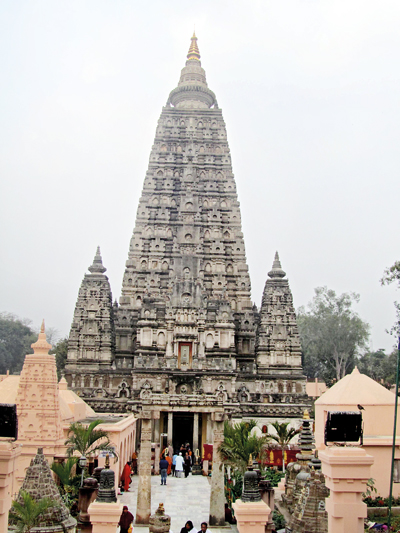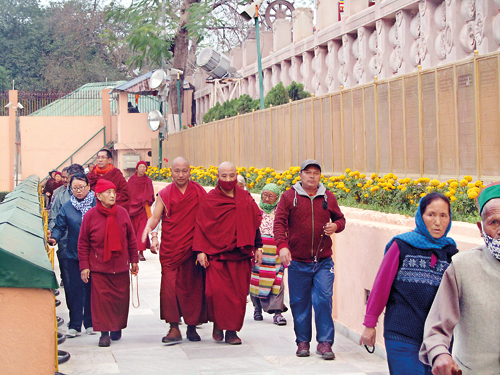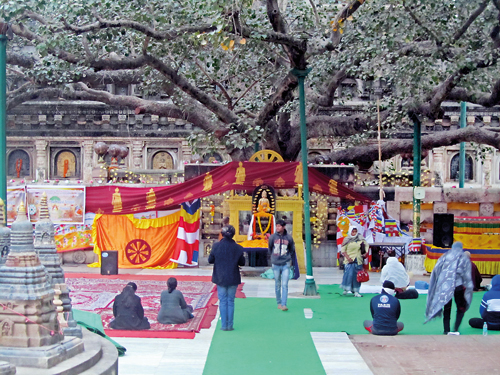In the presence of serenity, sanctity and beauty at Bodhgaya

The Bodhgaya shrine: Mahabodhi temple, a UNESCO World heritage site
Built in the third century BC by Indian Emperor Ashoka, the temple complex of Bodhgaya (or Buddhagaya as we know it in our country) in India’s Bihar state is a sacred site for the world’s 300 million Buddhists
It was at this very spot over 2500 years ago that one of the world’s great religions came into being – when the Indian prince Gauthama Siddhartha attained enlightenment and became The Buddha. After spending many days in meditation beneath a Bodhi tree at this site, he attained enlightenment when he realised the answer to the fundamental questions about why suffering existed in the world and how it could be eradicated.
Today the Mahabodhi temple complex, a UNESCO World Heritage site, stands at the site of the Buddha’s enlightenment – a shrine of ancient origin but much rebuilt and restored over the centuries. It is a place of pilgrimage for the world’s three hundred million Buddhists, and one is struck by the sheer variety of pilgrims here from various parts of the world: white clad devotees from Sri Lanka, monks in robes of saffron or maroon, Bhutanese and Burmese in traditional dress.
Visit the temple compound in the early hours of the morning and you can feel a deep sense of peace and serenity. It is a moving experience to be here when the pilgrims begin chanting just before dawn. You can make out different sounds – deep-throated sonorous tones from Tibetan monks, gentler Pali stanzas from groups of Thai pilgrims and soft singing accompanied by the percussion of a silvery bell from members of a black-robed Japanese sect. Surprisingly, the result is not discordant but a pleasing blend of sounds.

Pilgrims in different attire circum-ambulating the shrine
Visit later on during the morning and you see pilgrims briskly walking around the shrine along the rectangular perimeter path, fingering rosaries of prayer beads in their hands or twirling rotating prayer drums. I was intrigued by the many Tibetan monks I saw – some repeatedly falling prostate on the floor, others standing and softly mouthing words of chanting and yet others seated silently cross-legged on the ground reading or meditating.
Sacred Bodhi tree
Just behind the main temple is an ancient pipal or Bodhi tree (Ficus religiosa), a descendant of the very tree under which the Buddha attained enlightenment. Pilgrims can sit and meditate near this spot where the Buddha sat 25 centuries ago – or share (as I was fortunate enough to do) an early morning roti and conversation with a Ladakhi monk from the Himalayas – or simply absorb the sounds and ambience of this holy place.
Strolling around the courtyard are pilgrims and visitors in various shapes, sizes and dresses — saffron-clad Theravada monks from Sri Lanka and Thailand, Tibetan Mahayana monks in their Dalai Lama-like orange and purple robes, Westerners in traditional Indian dress, and Indians in jeans and woolly jumpers.
Origin of Buddhism

The Sacred Bodhi tree: Site of the Buddha’s enlightenment
Although Buddhism originated in India, the religion almost died out in that country a few centuries after the death of the Buddha. It spread however to neighbouring Sri Lanka, Myanmar and Thailand — countries in which today 80-90% of the population adheres to the Buddhist faith — and via the old silk routes through Pakistan and Afghanistan to China, Korea and Japan. It is pilgrims from these countries as well as Westerners interested in Buddhism who make up most of the visitors to Bodhgaya.
The first time we visited Bodhgaya, several years ago, we flew to Gaya airport (about 12 km from Bodhgaya) on a Sri Lankan Airlines direct flight. Sadly, our national airline no longer flies directly to Gaya, so Sri Lankans wishing to visit the birthplace of Buddhism have to either fly to Delhi or Varanasi (on Indian or Sri Lankan Airlines) from where they have to fly on Indian Airlines to Gaya airport or travel by road to Bodhgaya.
Lord Ronaldshay –the Governor of Bengal from 1917 and 1922 and subsequently Secretary of State for India between 1935 and 1940 – was one of the earliest presidents of the Mahabodhi Society of India which was established to revive Buddhism in that country. One of his better known and oft quoted observations is this:
“It is not necessary to be an actual adherent of the Buddhist faith to be a reverent admirer of the life and teachings of its founder.”
And in like vein, I might observe after our visit there that a visitor to Bodhgaya does not have to be a Buddhist to appreciate the serenity, the sanctity and the beauty of this holy place.


